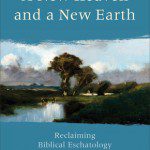 Karl Giberson’s new book, The Wonder of the Universe: Hints of God in Our Fine-Tuned World, is divided into two parts. Part One describes the wonder of our universe, the process of discovery that led to our modern understanding of the universe, and the fine-tuning of the cosmological constants that make life on our planet possible. Giberson is an excellent writer and he tells this story well. Part Two looks at design arguments in more detail. But between these two sections Giberson has an interlude – a look at the nature of science and the nature of scientific investigation. This interlude is the focus of today’s post.
Karl Giberson’s new book, The Wonder of the Universe: Hints of God in Our Fine-Tuned World, is divided into two parts. Part One describes the wonder of our universe, the process of discovery that led to our modern understanding of the universe, and the fine-tuning of the cosmological constants that make life on our planet possible. Giberson is an excellent writer and he tells this story well. Part Two looks at design arguments in more detail. But between these two sections Giberson has an interlude – a look at the nature of science and the nature of scientific investigation. This interlude is the focus of today’s post.
Giberson begins his discussion of the nature of scientific investigation with a quote from Dr. Mohler’s speech at the Ligonier Ministries 2010 National Conference. (Giberson starts the quote at “remember” – I’ve included a little more of the context.)
The assured results of modern science. There is so much that is packed in that mental category, that intellectual claim. Just remember first of all that science has changed and has gone through many transformations. The assured results of modern science today may very well not be the assured results of modern science tomorrow. And, I can promise you, are not the assured results of science yesterday.
I posted on Dr. Mohler’s speech a couple times shortly after it was given (Houston, We Still Have a Problem and Houston, Here’s the Situation). This speech is a clear and careful presentation of many of the aspects that Christians find troubling with an old earth and evolutionary creation. As such it provides an opportunity to interact with these concerns and consider alternative views. This view – that the assured results of science are provisional – is not unique to Dr. Mohler. It is expressed by many, from laypeople in our churches to Christian leaders, professors, and thinkers. I have heard variants of this concern even from some who are ready and willing to entertain or embrace an evolutionary understanding of creation.
In the interlude of his book Dr. Giberson frames the discussion to interact with this very common understanding about the “assured results of modern science.” He also looks at the counter claims – that science has “assured results” and that these either disprove God or prove God. This is an excellent section in the book – and I will outline some of the arguments below.
How do you view the “assured results of modern science”?
Is science an ever changing construct or is there something more fundamental?
How does this compare with the assured results of biblical interpretation?
Science is accumulative. Giberson begins his discussion by pointing out that the changes in “assured results” are not as profound as often assumed unless one retreats to the pre-scientific era, and perhaps not even then. There is a definite direction to scientific discovery as there is a direction to the passage of time.
The idea that science constantly changes is largely fiction, based on our lopsided familiarity with scientific revolutions and lack of awareness of ongoing ordinary science. The typical scientific advance … is one that extends, encompasses, and absorbs rather than refutes old understandings. Only rarely do new ideas require that old ideas be discarded.
Even truly revolutionary ideas are often compatible with many previous ideas. … Newton’s ideas have not been discarded; they have simply been shown to have a restricted domain of application. When I teach mechanics to engineering students, I use a textbook based entirely on Newton’s laws of motion. If Newton’s own treatment wasn’t so opaque, we could still be using his book from the seventeenth century. The revolution that “toppled Newton” was the discovery of certain extreme situations where his theory did not work. (p. 127-128)
This is an important concept – science builds and grows on the foundation of those who came before. Changes occur with new realms of observation and experience.
Science is a community exercise and a community conversation leading to community consensus.
The central ideas of science are never based entirely on the work of a few scientists. While certain great scientists like Darwin and Einstein may provide the initial flash of genius, the idea flows from the margins of science into a much larger world until thousands of skeptical specialists are thinking hard about it. … The moment a new idea appears in the scientific literature, critics spring into action, motivated by everything from self-defense to curiosity to an enthusiasm for knowledge to a desire to be famous. (p. 129)
I have come to realize recently how deeply engrained this approach is in my psyche. It gets me into trouble because in the larger world people do not expect such challenges and such apparent distrust. If someone, anyone, puts out numbers or ideas of any sort my immediate reaction is to test and prod until convinced. This isn’t malicious or a power play – or isn’t intended to be – but it is off-putting and misunderstood by those who do not expect to have to defend their statements or their statistics.
The arrogance of science is that absolutely nothing is accepted on authority. Everything is subject to dispute and requires defense. It is this process that builds consensus.
It is also important to understand that minority positions are not necessarily wrong. As Giberson points out, most if not all, consensus positions began as minority positions. But these minority positions will be subject to scrutiny and the onus is on the proponents to demonstrate that the ideas are true as it is also on those objecting and those simply interested to try to demonstrate that the ideas are false. Giberson uses the Intelligent Design arguments of Michael Behe as an example here. The general response to Behe’s ideas was not persecution (well, except by some militant atheists) but testing and prodding as is common in the scientific community. The largest problem with Intelligent Design today is that its proponents have put forth no positive evidence and the initial hypotheses have not stood up well to the tests and prods of others. Intelligent Design will wither and disappear if there is no explanatory value to the hypothesis and no evidence for its validity.
Does the process of consensus building in science lead you to trust or distrust the results? Why?
How Science Works: Giberson goes on in this interlude to explore the question of the nature of science and scientific investigation. The inductive method proposed by Francis Bacon is not a productive philosophy of science. It is far too limited and lacks predictive power. It is based on facts and probabilities rather than theories and predictions. The processes of modern science are far more sophisticated based in broad explanatory theories.
Ideas that prove reliable guides to new truths are like medicines that work – their proof is in their pudding. This is the best way to think about ideas that claim to be scientific. Does working with them generate new knowledge about the world? Do the ideas easily incorporate new information, as it is discovered? Do the ideas make startling and remarkable predictions that can be confirmed? (p. 137)
The Standard Model of particle physics predicts that the Higgs Boson which provides mass to all particles must exist. The Standard Model also sets limits on what the mass or energy of the Higgs Boson must be. The Large Hadron Collider (LHC) at Cern, like the now decommissioned Tevatron at Fermilab before it, is searching for evidence of the Higgs Boson. It now appears, so say my colleagues who work in this area, that such evidence has been found, although the statistics are not yet sufficient to claim that the Higgs Boson has been definitively observed. We anticipate that the particle will be officially discovered sometime this year when the LHC resumes measurements.
String theory strives to move beyond the Standard Model and provide a theory that explains, among other things, the properties of the Higgs Boson. These properties include its mass – something the Standard Model leaves as a empirically determined parameter.
Quantum theory is accepted because it works and it leads to new predictions and better understanding in some rather strange and counter-intuitive ways. The Standard Model is accepted for the same reason. If or when string theory in some form is accepted it will be for the same reason. Evolution is widely accepted as the foundational theory in biology because it works to both explain and predict – and it also leads to better understanding in some rather strange and counter-intuitive ways (although perhaps not as counter-intuitive as quantum theory or particle physics). Evolution is also widely accepted because connections with chemistry and physics provide mechanisms for the process of evolution that are plausible today and should be demonstrable in the future.
Do you think of science as inductive – building up probabilities from facts? What role should theories play in connecting these facts?
When should a theory be accepted?
What Science Can and Cannot Tell Us: There is one more important point in the consideration of the nature of science and the scientific method. In the last section of his interlude Giberson points out that science can address is the nature of what is, and this is all that science can address. It cannot provide meaning or value to these observations and theories. Science, on its own, cannot lead us conclusively either to or away from God. In the next section of the book he will look at design arguments, suggesting that they can take us part of the way to God … but no form of scientific investigation can provide a knock-down argument for the existence of God. We should not expect to find proof of God in science.
The Bible, for example, does not start with an examination of the natural world and conclude that there must be a God. Rather the biblical witness begins with the reality of God and uses that all-encompassing reality to understand the significance of the natural world. A Christian worldview thus starts from a foundation of faith in God and works out from there, or perhaps I should say down from there. It does not start from an inspection of the world and work up to God. (p. 142)
Giberson doesn’t put it quite this way – but I would say that the Christian worldview starts with the experience of God. It starts with His self-revelation in scripture, His self-revelation in the incarnation, His self-revelation in relationship with His people from Israel through to the church today, His self-revelation in the form of the Holy Spirit.
How far can science take us in the search for either meaning or God? What do we have reason to expect?
If you wish to contact me directly, you may do so at rjs4mail[at]att.net
If interested you can subscribe to a full text feed of my posts at Musings on Science and Theology.
Image Caption: Star-Birth Clouds in M16. This eerie, dark structure is a column of cool molecular hydrogen gas and dust that is an incubator for new stars. The color image is constructed from three separate images: Red show emission from singly-ionized sulfur atoms, green from hydrogen, and blue from doubly ionized oxygen atoms. Credit: Jeff Hester and Paul Scowen (Arizona State University) and NASA (public domain)











